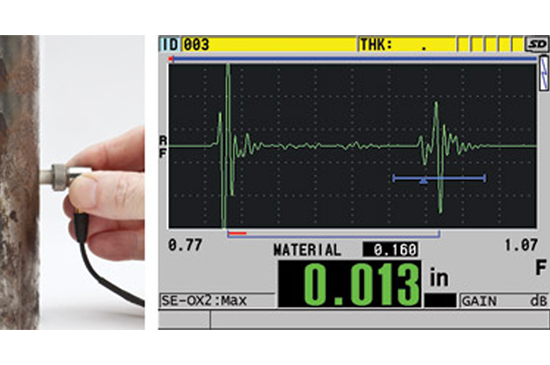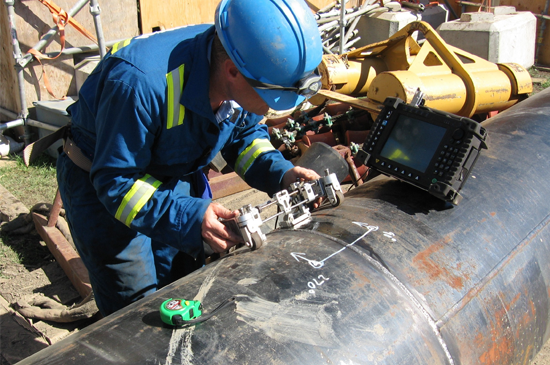- Time-of- flight diffraction (TOFD) method of ultrasonic testing is a sensitive and accurate method for the nondestructive testing of welds for defects. The use of TOFD enabled crack sizes to be measured more accurately, so that expensive components could be kept in operation as long as possible with minimal risk of failure.
- In a TOFD system, a pair of ultrasonic probes sits on opposite sides of a weld. One of the probes, the
transmitter, emits an ultrasonic pulse that is picked up by the probe on the other side, the receiver. In
undamaged pipes, the signals picked up by the receiver probe are from two waves: one that travels
along the surface and one that reflects off the far wall. When a crack is present, there isa diffraction of
the ultrasonic wave from the tip(s) of the crack. Using the measured time of flight of the pulse, the
depth of a crack tips can be calculated automatically by simple trigonometry.
- The ID oxide scale is produced by oxidation in the reheater and superheater. The scale build up
occurs when the tubes have experienced high temperatures for extended periods of time. The
formation of ID scale reduces heat transfer and results in a further increase of tube metal
temperature. The result is the ID scale feeds on itself and increases in thickness as it continues to
grow. The final outcome of excessive scale is a thick lipped, long term overheat failure.
- Ultrasonic Oxide Scale Measurement technique:
- The Ultrasonic method for measuring scale thickness is based on transmitting a wave through the
tube thickness. The thickness is calculated by measuring the time difference between the signals
reflected from the steel/scale interface and the tube ID surface. With advanced signal
interpretation techniques, we can achieve Oxide scale Thickness measurements up to the
resolution of 0.15 Microns.
- At Hertz Testing And Training Centre. we use Advanced Ultrasonic Equipments and
recommended accessories to perform Internal Oxide Scale Thickness measurements to ensure
accuracy and repeatability.
- Phased array ultrasonic testing (PAUT) is an advanced method of ultrasonic testing that has
applications in industrial nondestructive testing. Common applications are
to noninvasively examine the heart or to find flaws in manufactured materials such as welds.
- Phased array ultrasonic testing (PAUT) is widely used for nondestructive testing (NDT) in
several industrial sectors, such as construction, pipelines, and power generation. This method is
an advanced NDT method that is used to detect discontinuities i.e. cracks or flaws and thereby
determine component quality. Due to the possibility to control parameters such as beam angle
and focal distance, this method is very efficient regarding the defect detection and speed of
testing. Apart from detecting flaws in components, phased array can also be used for wall
thickness measurements in conjunction with corrosion testing. Phased array can be used for the
following industrial purposes:
- Inspection of welds
- Thickness measurements
- Corrosion inspection
- Flaw detection
- Rolling stock inspection (wheels and axles)


